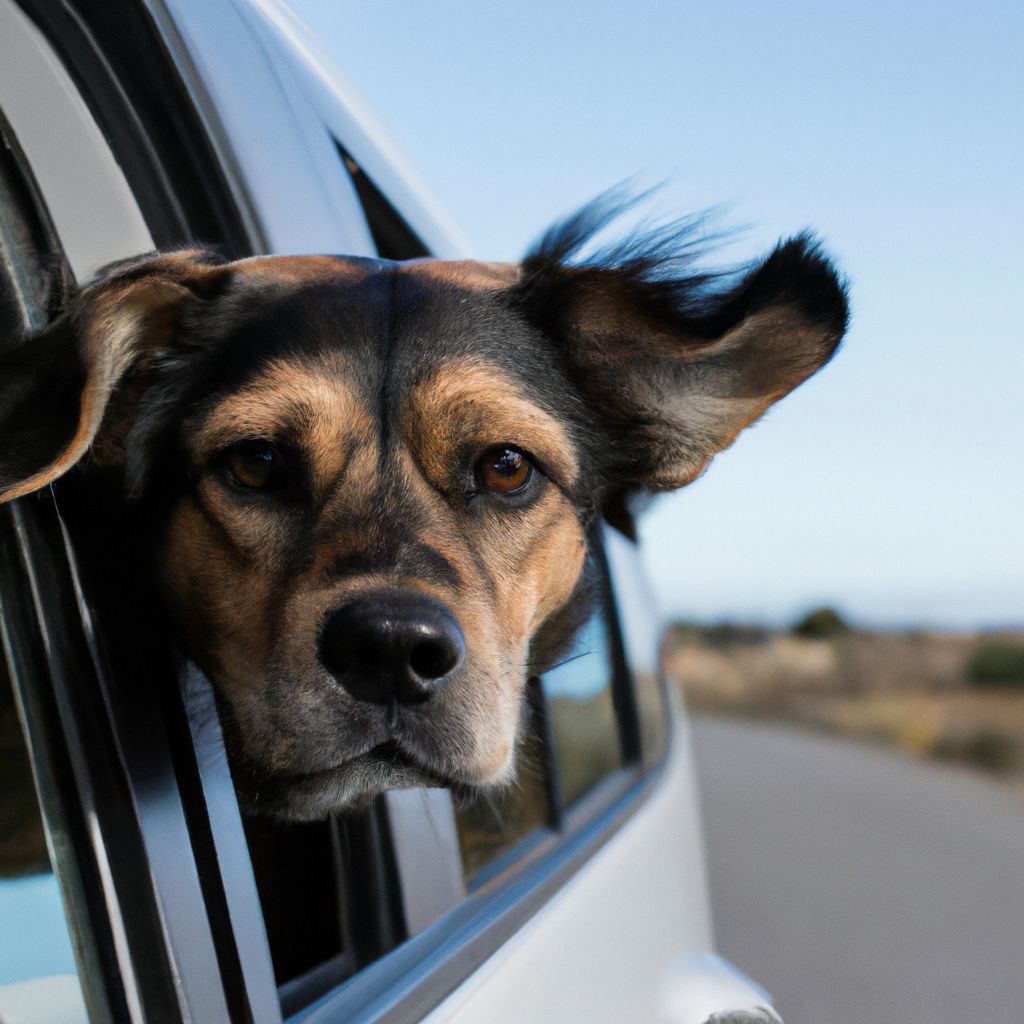Key Takeaways:
- Understanding and addressing dog anxiety in cars is important for both the well-being of the dog and the travel experience.
- Recognizing the symptoms of dog anxiety in cars is essential for early intervention and prevention of further distress.
- Prevention and training techniques, as well as non-medical calming aids and homeopathic remedies, can be effective in managing dog anxiety in cars.
Understanding the Importance of Addressing Dog Anxiety in Car
Addressing dog anxiety in cars is important. Dogs can experience anxiety and it can negatively affect their travel. Causes of car anxiety in dogs include motion sickness, fear of car rides, or prior bad experiences. Signs of anxiety include drooling, panting, restlessness, and aggression.
Preventing and training are key for managing car anxiety. Acclimate the pup to car rides with positive reinforcement and desensitization exercises. Create a comfortable environment with their favorite toys or bedding. To avoid motion sickness, keep their stomach empty before travel and consider medications.
Non-medical calming aids or homeopathic remedies can help ease anxious dogs. Pheromone sprays, herbal supplements, and music designed for relaxation work as natural remedies. In severe cases, prescription drugs may be needed. Consulting your vet for the appropriate medications and dosage is best.
Ultimately, addressing dog anxiety in cars helps both the pup and the overall travel experience. Recognize anxiety, use prevention/training techniques, and consider calming aids or homeopathic remedies. When in doubt, get advice from a vet.
Impact of Dog Anxiety on Travel Experience
Dog anxiety in cars can be a real pain. It can lead to bad behaviors, affect comfort, and even endanger safety. So, understanding how to deal with it is key.
Anxious dogs may bark, whine, pant, pace, drool, or even chew on seats. This kind of behavior can ruin a trip. Plus, it can make the owner's driving difficult. It can even cause aggression towards other passengers and physical sickness.
Dealing with dog anxiety in cars is important for everyone's well-being. First, recognize the signs. Then, use training techniques and calming aids. These could be non-medical remedies or medicines prescribed by the vet.
Overall, addressing dog anxiety is important for a pleasant travel experience. With the right methods and interventions, such as calming aids or medications, dogs can feel more comfortable during car journeys. This means a happier and less stressful travel experience for all.
Causes of Dog Anxiety in Car


Dogs can experience anxiety in cars for various reasons. Motion sickness can make them feel ill or dizzy. Fear of car rides may arise from negative experiences or lack of socialization to being in a car. Furthermore, the limited space of a car can make some dogs feel like they are trapped. These are possible causes of dog anxiety in cars.
Recognizing the Symptoms of Dog Anxiety in Car
Recognizing dog anxiety in the car is key. Symptoms such as panting, drooling, trembling, restlessness, whining, and attempts to escape all indicate distress. Dog owners must be able to spot these signs and take steps to help their pet feel calmer.
Every pup may show different signs or combinations of symptoms. Plus, they may have behaviors unique to their anxiety. Identifying these differences helps owners understand their pups and seek solutions.
To keep your furry friend safe, take action on car anxiety. Gradually desensitize, create a comfy environment, distract, and get professional help. With patience and support, your pup can overcome anxiety and love car rides.
Don't wait any longer – take steps now. Provide a stress-free car ride for your beloved pet!
Prevention and Training Techniques
Managing dog anxiety while driving involves strategies and methods. Dogs can get anxious, which shows in panting, whining, pacing, drooling, and even vomiting. To help your pup, try:
- Gradual Exposure: Start small and gradually make car trips longer. This helps them build positive associations.
- Positive Reinforcement: Reward with treats, praise, or toys during car rides. This can shift focus from anxiety to enjoyable experiences.
- Familiarization: Make the car a familiar, comfortable space with bedding or toys. This creates a sense of security.
- Calming Products: Use natural calming products like aromatherapy sprays or pheromone diffusers.
- Training Exercises: Use basic obedience training commands like sit-stay. This helps them feel secure and redirects focus.
- Consultation with a Professional: If anxiety persists, seek guidance from a pro. They can provide tailored techniques and advice.
Patience, consistency, and understanding are key. Additionally, ensure safety by having your pup in a harness or crate. Ventilation and breaks for the bathroom and exercise are also important.
17% of dogs experience anxiety during car rides (Journal of Veterinary Behavior).
Managing Motion Sickness in Dogs
Motion sickness in dogs is a common problem. Symptoms like drooling, vomiting, and panting can be seen. To manage it, strategies like these can help:
- Familiar environment: Make the car feel like home. Use familiar bedding and toys. This can reduce anxiety and motion sickness.
- Gradual exposure: Introduce car rides gradually. Start with short trips and increase duration and distance. This can desensitize them to motion.
- Avoid food before rides: A large meal before a car ride can increase motion sickness. Don't feed for a couple of hours before the journey.
- Anti-anxiety meds: In some cases, anti-anxiety meds prescribed by a vet can help calm nerves and reduce motion sickness.
- Alternative transport: If motion sickness is consistent, other options like crates or carriers may be better. This will provide a secure and stable environment.
Remember, every dog is different. Consult a vet for personalized advice.
Non-Medical Calming Aids and Homeopathic Remedies
Non-medical calming aids and homeopathic remedies can provide natural alternatives to pharmaceutical interventions for dogs experiencing anxiety during car rides. These include:
- fruit extracts
- herbal supplements
- aromatherapy
- pressure wraps
- noise-blocking products
- behavioral training techniques
It's important to consult a vet before using any of these methods to ensure they are suitable for the particular pup and to determine the right dosage or application. Plus, incorporating such aids into a dog's daily routine can not only help reduce anxiety during car rides but also promote general well-being and peace in the relationship between the pup and the owner.
A study published in the Journal of Veterinary Behavior confirms that some of these non-medical calming aids, like aromatherapy and pressure wraps, have proven to be effective in relieving dog anxiety during car rides.
Prescription Medications and Veterinary Guidance
Many dogs experience anxiety in cars. So, vets prescribe medications to give relief. These can provide comfort during travels.
Prescription meds can help manage anxiety for car travel. A vet will decide on the appropriate dosage and timing for the dog. Be aware of potential side effects before administering! Consult with a vet first.
Monitor the dog's response and adjust the dosage if needed. Alternative options, such as behavior modification or natural remedies, are worth considering.
Every dog may react differently to meds, so address any concerns with the vet. Take proactive steps to give your dog relief and support. Don't miss out on the opportunity to provide comfort for your furry friend!
Conclusion
Dog anxiety in cars can be an upsetting experience for both the dog and its owner. Knowing the symptoms of anxiety is important to provide solutions and ease distress. Symptoms may include panting, restlessness, pacing, whining, trembling, drooling, and attempts to escape. Knowing these signs can assist owners in taking the right steps to address dog anxiety and make car rides more comfortable.
To solve this issue, various approaches are possible. One way is to desensitize the dog to car rides through short, positive experiences in a controlled atmosphere. This can include going on shorter trips and gradually increasing the duration. Providing a familiar and cozy environment in the car, e.g. the dog's favorite blanket or toy can also reduce anxiety. Furthermore, using calming aids such as pheromone sprays or natural remedies might be beneficial in easing symptoms. It is important to consult a vet to determine the most suitable solution for the dog's needs.
Although the above-mentioned solutions and symptoms give a comprehensive understanding, each dog may have different needs and reactions. Thus, close observation and monitoring by owners are necessary to ensure their dog's safety during car rides. By being considerate of their dog's behavior and providing the right solutions, owners can help their canine companions overcome anxiety and make car rides a positive experience.
Some Facts About Understanding Dog Anxiety in Car Symptoms: Signs and Solutions:
- ✅ Dog car anxiety can cause symptoms such as shaking, panting, erratic activity, potty accidents, excessive drooling, whining, and barking. (Source: assisianimalhealth.com)
- ✅ Dogs may associate car rides with negative experiences, such as going to the vet or being left alone, leading to travel anxiety. (Source: Team Research)
- ✅ Desensitization and counterconditioning techniques can help dogs feel more comfortable in the car by gradually exposing them to positive car experiences. (Source: Team Research)
- ✅ Calming supplements, pheromones, homeopathic remedies, and soothing music can be used to help alleviate dog car anxiety. (Source: Team Research)
- ✅ In some cases, medication may be necessary to relieve anxiety and help dogs enjoy car travel, with antihistamines and sedatives being common options. (Source: Team Research)
FAQs about Understanding Dog Anxiety In Car Symptoms: Signs And Solutions
What are the signs of travel anxiety in dogs?
Signs of travel anxiety in dogs can include reluctance to get into the car, whining, panting, pacing, excessive drooling, yawning, lip licking, shaking, and trembling.
How can I help my dog feel calm in the car?
To help your dog feel calm in the car, you can try desensitization and counterconditioning techniques, use non-medical calming aids like ThunderShirts or pheromone products, create a comfortable environment with safety restraints and familiar items, and provide distractions such as puzzle feeders or soothing music.
What causes dog car anxiety?
Dog car anxiety can be caused by various factors, including negative past experiences, fear of unfamiliar environments, motion sickness, and associations with going to the vet or shelter.
What are some solutions for dog car anxiety?
Solutions for dog car anxiety may include desensitization and counterconditioning training techniques, the use of calming supplements or medications recommended by a veterinarian, creating positive associations with the car ride, and addressing any motion sickness your dog may experience.
Is there medication available to help dogs with travel anxiety?
Yes, in some cases, medication may be necessary to relieve anxiety and help dogs enjoy car travel. Antihistamines like diphenhydramine can be used, but it's important to consult with a veterinarian for specific recommendations and prescriptions.
How can I safely secure my dog in the car?
You can safely secure your dog in the car by using a travel crate, carrier, or travel harness attached to a seat belt. This helps prevent injuries and keeps your dog more secure during travel.




